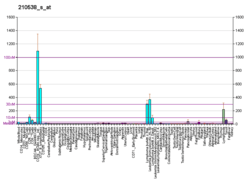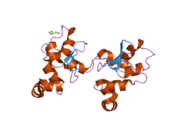Baculoviral IAP repeat-containing protein 3
Baculoviral IAP repeat-containing protein3 (also known as cIAP2) is a protein that in humans is encoded by the BIRC3 gene.[5][6]
cIAP2 is a member of the inhibitor of apoptosis family that inhibit apoptosis by interfering with the activation of caspases. The encoded protein inhibits apoptosis induced by serum deprivation but does not affect apoptosis resulting from exposure to menadione, a potent inducer of free radicals. The cIAP2 protein contains three BIR domains, a UBA domain, a CARD domain and a RING finger domain. Transcript variants encoding the same isoform have been identified.[7]
Interactions
Baculoviral IAP repeat-containing protein 3 has been shown to interact with:
gollark: As ever, I continue being right.
gollark: As always.
gollark: Wow, my ban was retroactively justified perfectly.
gollark: Tux1 is a member of the set ∀N∈ℝ TuxN.
gollark: Well, I guess you have 11 days and 13 hours on the server.
References
- GRCh38: Ensembl release 89: ENSG00000023445 - Ensembl, May 2017
- GRCm38: Ensembl release 89: ENSMUSG00000032000 - Ensembl, May 2017
- "Human PubMed Reference:". National Center for Biotechnology Information, U.S. National Library of Medicine.
- "Mouse PubMed Reference:". National Center for Biotechnology Information, U.S. National Library of Medicine.
- Liston P, Roy N, Tamai K, Lefebvre C, Baird S, Cherton-Horvat G, Farahani R, McLean M, Ikeda JE, MacKenzie A, Korneluk RG (February 1996). "Suppression of apoptosis in mammalian cells by NAIP and a related family of IAP genes". Nature. 379 (6563): 349–53. doi:10.1038/379349a0. PMID 8552191.
- Rothe M, Pan MG, Henzel WJ, Ayres TM, Goeddel DV (February 1996). "The TNFR2-TRAF signaling complex contains two novel proteins related to baculoviral inhibitor of apoptosis proteins". Cell. 83 (7): 1243–52. doi:10.1016/0092-8674(95)90149-3. PMID 8548810.
- "Entrez Gene: BIRC3 baculoviral IAP repeat-containing 3".
- Deveraux QL, Roy N, Stennicke HR, Van Arsdale T, Zhou Q, Srinivasula SM, Alnemri ES, Salvesen GS, Reed JC (1998). "IAPs block apoptotic events induced by caspase-8 and cytochrome c by direct inhibition of distinct caspases". EMBO J. 17 (8): 2215–23. doi:10.1093/emboj/17.8.2215. PMC 1170566. PMID 9545235.
- Bertrand MJ, Milutinovic S, Dickson KM, Ho WC, Boudreault A, Durkin J, Gillard JW, Jaquith JB, Morris SJ, Barker PA (2008). "cIAP1 and cIAP2 facilitate cancer cell survival by functioning as E3 ligases that promote RIP1 ubiquitination". Mol. Cell. 30 (6): 689–700. doi:10.1016/j.molcel.2008.05.014. PMID 18570872.
- Roy N, Deveraux QL, Takahashi R, Salvesen GS, Reed JC (1997). "The c-IAP-1 and c-IAP-2 proteins are direct inhibitors of specific caspases". EMBO J. 16 (23): 6914–25. doi:10.1093/emboj/16.23.6914. PMC 1170295. PMID 9384571.
- Li X, Yang Y, Ashwell JD (2002). "TNF-RII and c-IAP1 mediate ubiquitination and degradation of TRAF2". Nature. 416 (6878): 345–7. doi:10.1038/416345a. PMID 11907583.
- Uren AG, Pakusch M, Hawkins CJ, Puls KL, Vaux DL (1996). "Cloning and expression of apoptosis inhibitory protein homologs that function to inhibit apoptosis and/or bind tumor necrosis factor receptor-associated factors". Proc. Natl. Acad. Sci. U.S.A. 93 (10): 4974–8. doi:10.1073/pnas.93.10.4974. PMC 39390. PMID 8643514.
- Yoneda T, Imaizumi K, Maeda M, Yui D, Manabe T, Katayama T, Sato N, Gomi F, Morihara T, Mori Y, Miyoshi K, Hitomi J, Ugawa S, Yamada S, Okabe M, Tohyama M (2000). "Regulatory mechanisms of TRAF2-mediated signal transduction by Bcl10, a MALT lymphoma-associated protein". J. Biol. Chem. 275 (15): 11114–20. doi:10.1074/jbc.275.15.11114. PMID 10753917.
- Mace PD, Linke K, Feltham R, Schumacher FR, Smith CA, Vaux DL, Silke J, Day CL (2008). "Structures of the cIAP2 RING domain reveal conformational changes associated with ubiquitin-conjugating enzyme (E2) recruitment". J. Biol. Chem. 283 (46): 31633–40. doi:10.1074/jbc.M804753200. PMID 18784070.
Further reading
- Bertoni F, Cavalli F, Cotter FE, Zucca E (2003). "Genetic alterations underlying the pathogenesis of MALT lymphoma". Hematol. J. 3 (1): 10–3. doi:10.1038/sj.thj.6200146. PMID 11960389.
- Uren AG, Pakusch M, Hawkins CJ, et al. (1996). "Cloning and expression of apoptosis inhibitory protein homologs that function to inhibit apoptosis and/or bind tumor necrosis factor receptor-associated factors". Proc. Natl. Acad. Sci. U.S.A. 93 (10): 4974–8. doi:10.1073/pnas.93.10.4974. PMC 39390. PMID 8643514.
- Rajcan-Separovic E, Liston P, Lefebvre C, Korneluk RG (1997). "Assignment of human inhibitor of apoptosis protein (IAP) genes xiap, hiap-1, and hiap-2 to chromosomes Xq25 and 11q22-q23 by fluorescence in situ hybridization". Genomics. 37 (3): 404–6. doi:10.1006/geno.1996.0579. PMID 8938457.
- Roy N, Deveraux QL, Takahashi R, et al. (1998). "The c-IAP-1 and c-IAP-2 proteins are direct inhibitors of specific caspases". EMBO J. 16 (23): 6914–25. doi:10.1093/emboj/16.23.6914. PMC 1170295. PMID 9384571.
- Deveraux QL, Roy N, Stennicke HR, et al. (1998). "IAPs block apoptotic events induced by caspase-8 and cytochrome c by direct inhibition of distinct caspases". EMBO J. 17 (8): 2215–23. doi:10.1093/emboj/17.8.2215. PMC 1170566. PMID 9545235.
- Young SS, Liston P, Xuan JY, et al. (1999). "Genomic organization and physical map of the human inhibitors of apoptosis: HIAP1 and HIAP2". Mamm. Genome. 10 (1): 44–8. doi:10.1007/s003359900940. PMID 9892732.
- Horrevoets AJ, Fontijn RD, van Zonneveld AJ, et al. (1999). "Vascular endothelial genes that are responsive to tumor necrosis factor-alpha in vitro are expressed in atherosclerotic lesions, including inhibitor of apoptosis protein-1, stannin, and two novel genes". Blood. 93 (10): 3418–31. PMID 10233894.
- Suzuki H, Motegi M, Akagi T, et al. (1999). "API1-MALT1-MLT is involved in mucosa-associated lymphoid tissue lymphoma with t(11;18)(q21;q21)". Blood. 94 (9): 3270–1. PMID 10610122.
- Huang H, Joazeiro CA, Bonfoco E, et al. (2000). "The inhibitor of apoptosis, cIAP2, functions as a ubiquitin-protein ligase and promotes in vitro monoubiquitination of caspases 3 and 7". J. Biol. Chem. 275 (35): 26661–4. doi:10.1074/jbc.C000199200. PMID 10862606.
- Verhagen AM, Ekert PG, Pakusch M, et al. (2000). "Identification of DIABLO, a mammalian protein that promotes apoptosis by binding to and antagonizing IAP proteins". Cell. 102 (1): 43–53. doi:10.1016/S0092-8674(00)00009-X. PMID 10929712.
- Baens M, Steyls A, Dierlamm J, et al. (2001). "Structure of the MLT gene and molecular characterization of the genomic breakpoint junctions in the t(11;18)(q21;q21) of marginal zone B-cell lymphomas of MALT type". Genes Chromosomes Cancer. 29 (4): 281–91. doi:10.1002/1098-2264(2000)9999:9999<::AID-GCC1036>3.0.CO;2-I. PMID 11066071.
- Werneburg BG, Zoog SJ, Dang TT, et al. (2001). "Molecular characterization of CD40 signaling intermediates". J. Biol. Chem. 276 (46): 43334–42. doi:10.1074/jbc.M104994200. PMID 11562359.
- Suzuki Y, Imai Y, Nakayama H, et al. (2001). "A serine protease, HtrA2, is released from the mitochondria and interacts with XIAP, inducing cell death". Mol. Cell. 8 (3): 613–21. doi:10.1016/S1097-2765(01)00341-0. PMID 11583623.
- Li X, Yang Y, Ashwell JD (2002). "TNF-RII and c-IAP1 mediate ubiquitination and degradation of TRAF2". Nature. 416 (6878): 345–7. doi:10.1038/416345a. PMID 11907583.
- Gordon GJ, Appasani K, Parcells JP, et al. (2002). "Inhibitor of apoptosis protein-1 promotes tumor cell survival in mesothelioma". Carcinogenesis. 23 (6): 1017–24. doi:10.1093/carcin/23.6.1017. PMID 12082024.
- Sharief MK, Noori MA, Zoukos Y (2002). "Reduced expression of the inhibitor of apoptosis proteins in T cells from patients with multiple sclerosis following interferon-beta therapy". J. Neuroimmunol. 129 (1–2): 224–31. doi:10.1016/S0165-5728(02)00185-6. PMID 12161039.
- Ekedahl J, Joseph B, Grigoriev MY, et al. (2002). "Expression of inhibitor of apoptosis proteins in small- and non-small-cell lung carcinoma cells". Exp. Cell Res. 279 (2): 277–90. doi:10.1006/excr.2002.5608. PMID 12243753.
External links
This article is issued from Wikipedia. The text is licensed under Creative Commons - Attribution - Sharealike. Additional terms may apply for the media files.






